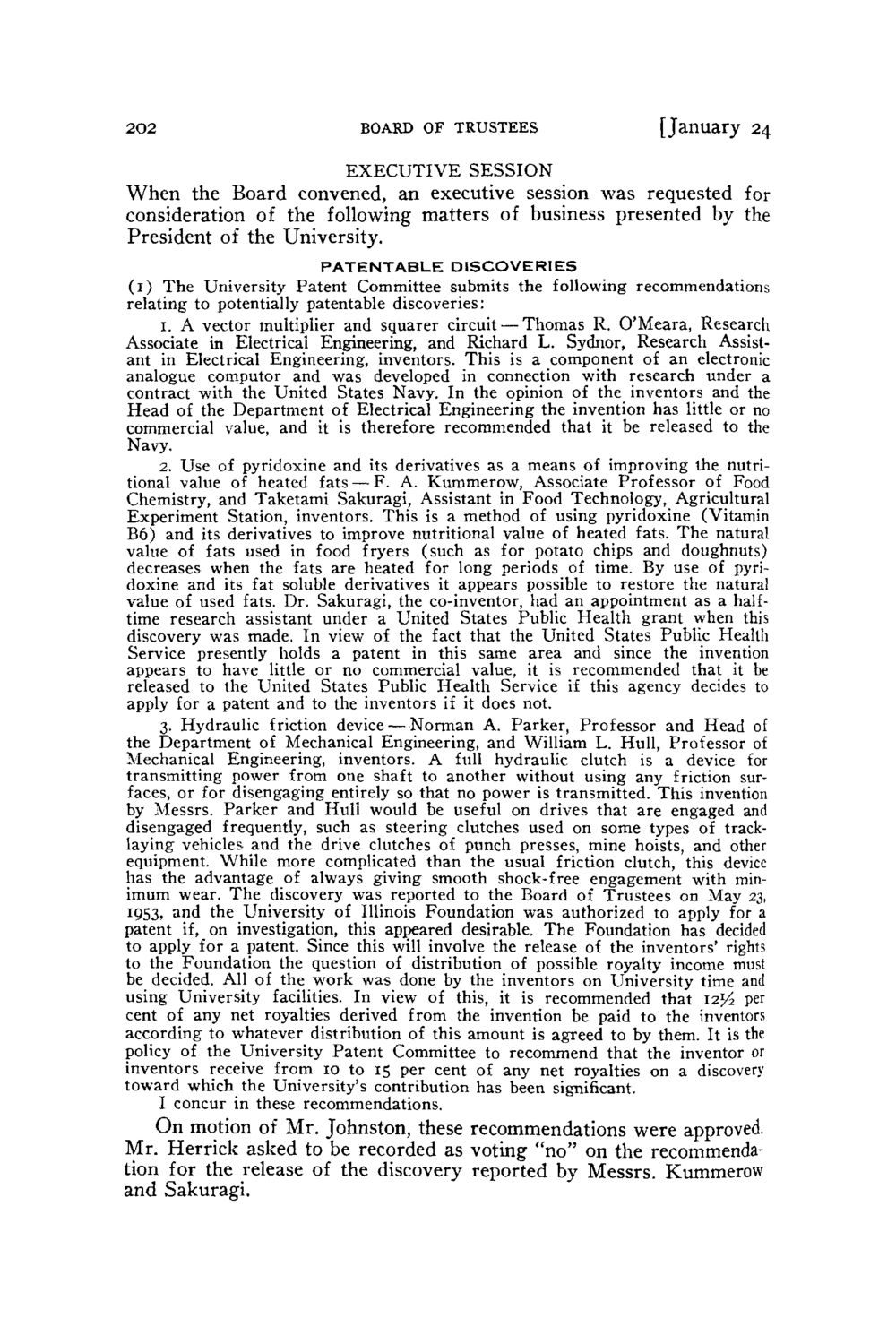| |
| |
Caption: Board of Trustees Minutes - 1956
This is a reduced-resolution page image for fast online browsing.

EXTRACTED TEXT FROM PAGE:
202 BOARD OF TRUSTEES [January 24 EXECUTIVE SESSION When the Board convened, an executive session was requested for consideration of the following matters of business presented by the President of the University. PATENTABLE DISCOVERIES (1) The University Patent Committee submits the following recommendations relating to potentially patentable discoveries: 1. A vector multiplier and squarer circuit — Thomas R. O'Meara, Research Associate in Electrical Engineering, and Richard L. Sydnor, Research Assistant in Electrical Engineering, inventors. This is a component of an electronic analogue computor and was developed in connection with research under a contract with the United States Navy. In the opinion of the inventors and the Head of the Department of Electrical Engineering the invention has little or no commercial value, and it is therefore recommended that it be released to the Navy. 2. Use of pyridoxine and its derivatives as a means of improving the nutritional value of heated fats — F . A. Kummerow, Associate Professor of Food Chemistry, and Taketami Sakuragi, Assistant in Food Technology, Agricultural Experiment Station, inventors. This is a method of using pyridoxine (Vitamin B6) and its derivatives to improve nutritional value of heated fats. T h e natural value of fats used in food fryers (such as for potato chips and doughnuts) decreases when the fats are heated for long periods of time. By use of pyridoxine and its fat soluble derivatives it appears possible to restore the natural value of used fats. Dr. Sakuragi, the co-inventor, had an appointment as a halftime research assistant under a United States Public Health grant when this discovery was made. In view of the fact that the United States Public Health Service presently holds a patent in this same area and since the invention appears to have little or no commercial value, it is recommended that it be released to the United States Public Health Service if this agency decides to apply for a patent and to the inventors if it does not. 3. Hydraulic friction d e v i c e — N o r m a n A. Parker, Professor and Head of the Department of Mechanical Engineering, and William L. Hull, Professor of Mechanical Engineering, inventors. A full hydraulic clutch is a device for transmitting power from one shaft to another without using any friction surfaces, or for disengaging entirely so that no power is transmitted. This invention by Messrs. P a r k e r and Hull would be useful on drives that are engaged and disengaged frequently, such as steering clutches used on some types of tracklaying vehicles and the drive clutches of punch presses, mine hoists, and other equipment. While more complicated than the usual friction clutch, this device has the advantage of always giving smooth shock-free engagement with minimum wear. T h e discovery was reported to the Board of Trustees on May 23, 1953, and the University of Illinois Foundation was authorized to apply for a patent if, on investigation, this apneared desirable. The Foundation has decided to apply for a patent. Since this will involve the release of the inventors' rights to the Foundation the question of distribution of possible royalty income must be decided. All of the work was done by the inventors on University time and using University facilities. In view of this, it is recommended that I2J4 per cent of any net royalties derived from the invention be paid to the inventors according to whatever distribution of this amount is agreed to by them. It is the policy of the University Patent Committee to recommend that the inventor or inventors receive from 10 to 15 per cent of any net royalties on a discovery toward which the University's contribution has been significant. I concur in these recommendations. On motion of Mr. Johnston, these recommendations were approved. Mr. Herrick asked to be recorded as voting "no" on the recommendation for the release of the discovery reported by Messrs. Kummerow and Sakuragi.
| |